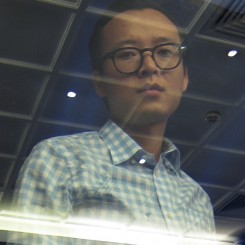As a preview to the exhibition “ON | OFF: China’s Young Artists in Concept and Practice,” randian is publishing a series of conversations in the lead-up to the opening, offering insights into the concept and planning of the show, and the perspectives of participating artists.
“ON | OFF: China’s Young Artists in Concept and Practice,” an exhibition of the work of 50 young mainland Chinese artists, will open at UCCA (Ullens Center for Contemporary Art) in Beijing on January 13, 2013. Curated by Sun Dongdong and Bao Dong, the exhibition aims to survey the work of these artists in the tense context of recent Chinese history and their experience of life and artistic practice. Iona Whittaker met artist Huang Ran to discuss the exhibition in the final weeks of its preparation.
Iona Whittaker: What does the title “ON | OFF” evoke for you?
Huang Ran: I really don’t know! Maybe that’s the title for people who consider the show as a whole. Personally I don’t feel attached to the title. You can give this title many readings; I don’ think it can cast light on individual artists, but when people talk about this show, they talk about the whole generation – I guess people have expectations of what this generation can do; they try to push it, to define the boundaries, the potential energy and also the limitations for it.
IW: Can you briefly introduce the work(s) you will be showing in the exhibition?
HR: I’m showing an installation which is made up of huge electronic filaments, laser-cut so that the details are very fine – almost too fine, too shiny. Panels are attached to high-voltage generators – it’s huge – and there are a lot of bubble machines, constantly blowing bubbles. When these come into contact with the panels, they create electric shocks, so you will hear the sound and see the light from these.
IW: How do you conceive the relations between your work and the curatorial framework of this exhibition?
HR: I think the curatorial framework is very open – with other exhibitions I feel you have a very clear sense of the work being made to serve a theme or idea; perhaps next year they will continue this format, with new people joining in.
IW: What’s on your mind for this show?
HR: I think I’m just trying to show a piece of my work! And trying to do the best for my part.
IW: What do you feel you share in common with the other artists in the exhibition?
HR: I think we do share a lot of things – this is very general, it’s not particular. I think a lot of us have quite similar concerns; it’s not as if one needs the other, but it sometimes happens very naturally. I think that from this point of view this generation is capable of defining what it really wants, and its own concerns. The artists have their own way to develop their practice, so sometimes if you see some trends in what is happening, you might feel they are sharing information, ideas or concepts.
IW: The current moment presents us increasingly with choices and different perspectives from which to view our situation. How do you think this affects art?
HR: Maybe I interpret “choices” as “chances” – so there are many more chances. But perhaps it has always been this way. Maybe I can understand it thus: when you don’t have that much choice, and people cannot perceive you through very many different perspectives, maybe people consider art “unlimited”, for example in terms of a spiritual power. But now, when there are so many choices available and when people have some many angles from which to look at you, I think it is the task of art to define the limits, and to operate within and in awareness of those limits. You have to touch the boundaries.
IW: How do you understand the current broader conditions for emerging artists today – what are the barriers and edges for you?
HR: I think this is close to the previous question. As you are working and you become more engaged with this system, you gain a perspective on what it looks like and the way you work. As you continue working, you see more clearly the relationship between your practice and that of others.
IW: What is the most significant question facing your artistic practice now?
The relationship between my individual practice and this system has made me question many times whether my practice is capable of making the system pay a tiny bit of the price for it. The system makes the individual pay a high price to keep the whole thing pushing forward, but whether the individual is able to make the system pay is the question, especially when the system is saturated with so many practitioners.



